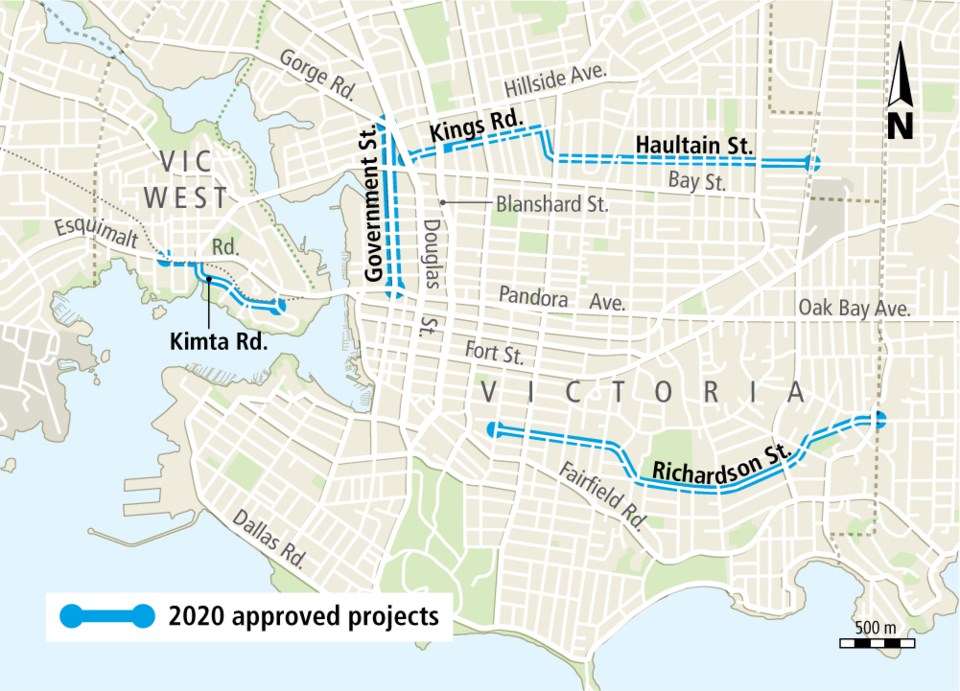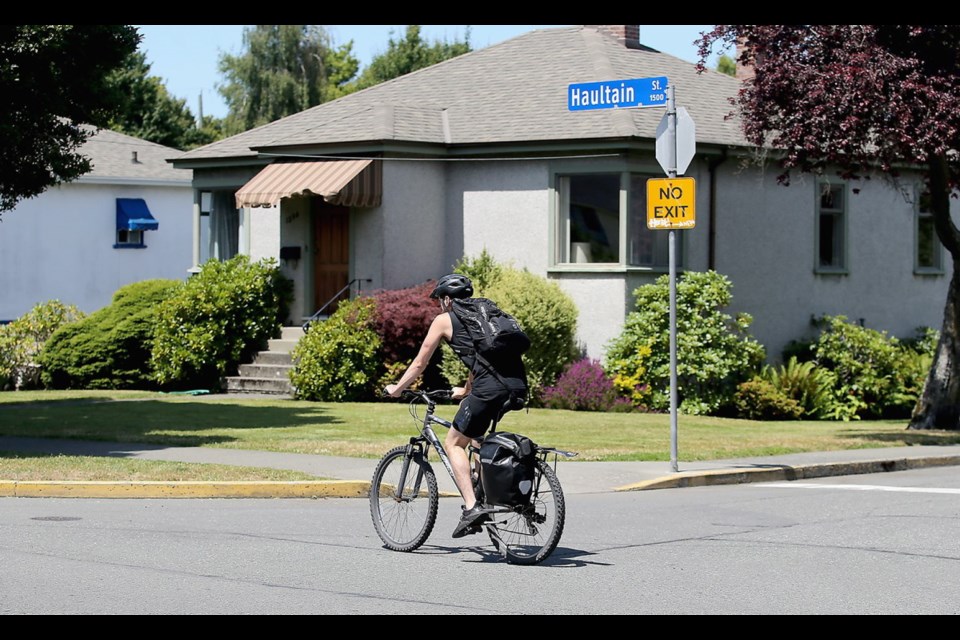Victoria city councillors have approved designs for the next eight kilometres of bike routes that will link the downtown cycling network to the E&N Trail on the west and key neighbourhoods to the east.
The four projects, which are expected to cost about $6.5 million, will be included in the 2021 draft budget discussions this fall.
Mayor Lisa Helps said the projects are well positioned to receive federal grants aimed at stimulating economic recovery in the wake of COVID-19.
“This is a perfect candidate and I just feel it’s important to signal that we will build this,” she said in an interview.
“If we could do it with 80 cents on every dollar from Ottawa, that would be even more amazing.”
Other councillors, however, cautioned that financial pressures created by the ongoing pandemic could force the city to put some of its plans on hold.
“The extent of the work that we’re going to be able to do over the next one or two years may be subject to some further considerations as we look at what we already know will be a really difficult budgeting situation,” Coun. Geoff Young said.
The city has already completed four kilometres of its planned 32-kilometre all-ages and abilities cycling network, and another nine kilometres are either under construction or approved for construction this year.
If an additional eight kilometres get built in 2021, the city will be two-thirds of the way toward completing the entire network. Once finished, 95 per cent of the municipality will be within 500 metres of a cycling route.
“We started with downtown because it’s the most unsafe, but we know that people want to get from home to school, from home to parks, from home to recreation centres,” Helps said.
“So the next phase — these eight kilometres approved today — will start to connect out into the neighbourhoods and provide safety for people who don’t feel safe right now and therefore don’t ride their bikes.”

The project designs approved at committee of the whole Thursday include:
• A 2.9-kilometre shared-use bikeway along Kings Road and Haultain Street from Douglas Street to Richmond Road. Traffic-calming measures will reduce vehicle speeds to 30 km/h and lower traffic volumes to 500-1,000 vehicles day from up to 3,000 per day in some areas. The design includes a previously approved pedestrian-controlled traffic signal at Kings and Blanshard slated for construction this year.
• A 1.2-kilometre route that uses Kimta Road to link the city’s downtown cycling network to the E&N Regional Trail in Vic West. The design includes an off-street bike path from Robert Street to Catherine Street on the south side of Esquimalt Road; a two-way protected bike lane on the north side of Kimta from Catherine Street to Tyee Street; and upgrades to the existing multi-use pathway in front of the Delta Hotel, a staff report says.
• A 1.1-kilometre stretch of one-way bike lanes, buffered by on-street parking, along Government Street from Pandora Avenue to Gorge Road, linking the downtown network to the Kings-Haultain corridor and a future cycling route on Gorge Road. The existing four vehicle traffic lanes will be reduced to three with 36 new parking spots, a new traffic signal and three new pedestrian crossings.
• A 2.8-kilometre shared-use corridor along Richardson Street from 91ԭ�� Street to Foul Bay Road, linking the core area network to the Fairfield-Gonzales neighbourhood, Rockland and the District of Oak Bay. As on the Kings-Haultain corridor, traffic calming will reduce speeds to 30 km/h and traffic volumes to fewer than 1,000 vehicles a day from the current 2,800 to 3,800 trips a day. Transit service will remain on the street.
The first three routes received unanimous approval, but Young and Coun. Charlayne Thornton-Joe voted against the Richardson design.
Young raised concerns about its $1.7-million cost and the potential impact that traffic diversions will have on nearby streets.
“There’ll be people who are getting more traffic and they don’t even know it yet, because they don’t know how the streets are going to work,” he said.
Young suggested a better approach would be to put in low-cost traffic diversion and see how people adapt. “Basically, do it step by step,” he said.
Corey Burger, policy and infrastructure chair of the Greater Victoria Cycling Coalition, said the long-awaited changes are a “game-changer” for the city’s cycling network.
“It’s really the first time the network is going to reach into places like Fernwood and Fairfield, which has some of the highest biking rates anywhere in Canada, actually,” he said.
“So this opens up a big change for those neighbourhoods in terms of providing a way to get to downtown and through downtown and between the neighbourhoods in a way that wasn’t possible before.”
As for the Kimta route, Burger said that represents an “amazingly crucial” link between the downtown network and the biking trails.
He expressed appreciation as well that the city listened to the coalition’s early concerns about the Richardson route and are now proposing a shared roadway with significantly lower traffic volumes.
“That was a fantastic pivot and we’re really pleased to see that,” he said.
“Kudos to staff for recognizing that, ‘Hey, maybe the first cut wasn’t quite right, but this one’s going to be great.’ ”



